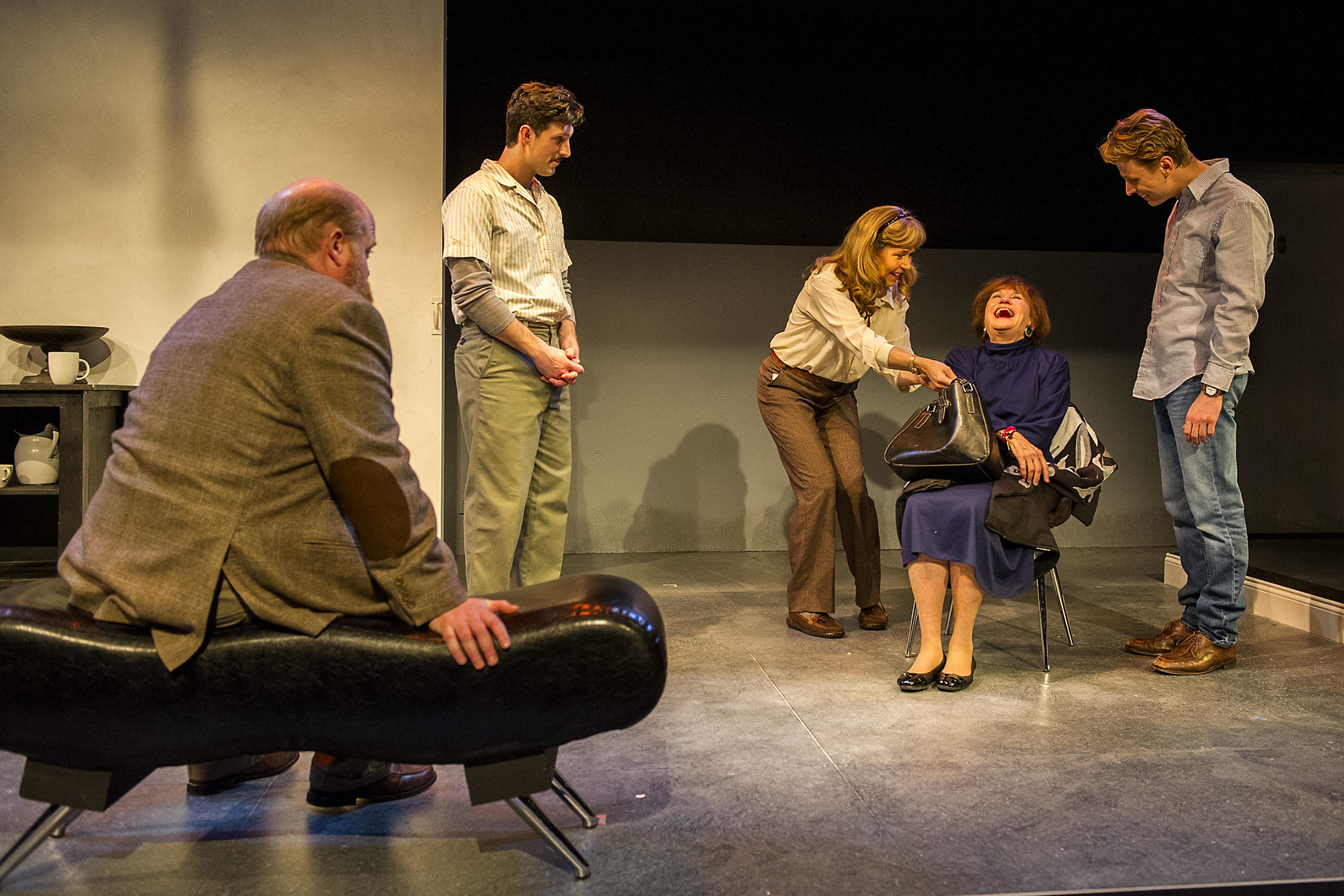We’ve had a running joke in our house about much how we enjoy a production that’s “ultimately life-affirming” after seeing one billed that way years ago. The show was superb, and I wanted to scrub the depressing, kinda icky residue out of my memory with a pumice stone and some strong lye soap for a few days afterwards. The life-affirming part, I think, was that none of the lives portrayed was my own. So I’m going to be cautious in describing The Waverly Gallery, on stage now at Shakespeare & Company.
This play is many things, but it is not ultimately life-affirming.
The staging of this Pulitzer Prize finalist by Kenneth Lonergan is, however, superb. And now, at a point in life where I want AARP to leave me the hell alone for just a few more years, I know that the last thing I should hope for is the memory of the show to fade from my mind. For the tale of The Waverly Gallery is spun into a rapidly tangling, decaying skein of memories, that call out to be preserved, not as a fictional offering, but as a personal, if indirect, plea.
Directed by Tina Packer, the season opener introduces us to a family that has clearly been dealing with the deteriorating faculties of the matriarch, Gladys Green, played by Annette Miller, for some time. Occasional narration by Gladys’s grandson, Daniel Reed, played by David Gow, provides both background and interpretation for the audience, who, from the beginning, are unwitting confessors, sitting in the close, intimate darkness. Danny reveals behaviors and attitudes of which he is not proud, but then neither for which he seems particularly contrite.
By the play’s end, acceptance that the youngest family member must be the most reliable narrator comes naturally. Not only is his twenty-something year old memory most trustworthy, but also acts as a Rosetta Stone, helping to decipher the motivations and perspectives of the rest of the cast as they interact with Gladys, who in her day, was a Greenwich Village legend for her social and political activism. A retired lawyer (who threatens to come out of retirement), she now runs a gallery for lost souls, such as blue-collar worker-cum-painter Don Bowman, played with the right amount of naïveté by David Bertoldi, who finds his way from Lynn, Mass., with nothing but the clothes on his back and the station wagon he’s planning to use as his residence. Gladys, naturally, takes him under her wing immediately.
Many of these interactions play out, at least at the top of Act I, with a certain level of predictability. That familiarity with the expected flow of conversation is deceptive, though. Of course the awkward tension of trying to have a discussion with a dementia sufferer is going to be funny. Oh sure, we know we shouldn’t laugh, and we wouldn’t (at least openly) if Gladys were our mother or grandmother, but we can’t resist a genuine, hearty chuckle at the conversational absurdity. It’s in our comedic DNA. And it’s the only way to deal with a subject so not-fucking-funny as Alzheimer’s. So we laugh, and the yucks are woven from Lonergan’s own life experiences, so we have the playwright’s permission. Right?
If the action stretched out over the course of a day, or even a weekend, we might be able to kid ourselves of that. But Gladys’s family lives with her deterioration full-time, and we realize that the jokes wore thin some time ago. Lonergan points to the fine, treacherous line between being able to laugh at a difficult situation and allowing necessary emotional distance to become a detached indifference.
The Waverly Gallery
by Kenneth Lonergan
Directed by Tina Packer
On stage at Shakespeare & Company
May 23 – July 14
No one walks that thin line as much as Gladys’s daughter, Ellen Fine, played by Elizabeth Aspenlieder. Ellen, trying to maintain a life with her second husband, Howard Fine, played by Michael F. Toomey, is forced to shoulder the burden of increasing responsibility for her mother’s health. Aspenlieder portrays Ellen’s caustic ambivalence towards that burden with such subtly measured doses of emotion that it’s uncomfortably easy to find yourself brimming with compassion for a daughter’s loyalty one moment and then roundly condemning her for perfectly human shortcomings the next. Aspenlieder conveys the strain of the terminal caretaker with a humanity that grounds the production and holds up a much-needed mirror to our own susceptibility to obligation resentment and compassion fatigue.
Toomey’s Howard, Ellen’s second husband, is artfully overstuffed and gleefully grating on the nerves. His harmless pomposity is worth enduring as the price of the carefully timed moments of pressure release that Lonergan affords us. Toomey supplies a larger-than-life depiction of that larger-than-life relative who is quick with one-size-fits-all solutions. His bluntness towards and about Gladys isn’t quite blameless, though neither is it belligerent. In it’s own way, what at first comes across as Howard’s lack of compassion for his mother-in-law’s condition reveals a determined respect for a mind that he seems to feel can be jolted back to present day reality with equal doses veracity and volume.
David Gow wears the character of Ellen’s son, Daniel, with a fascinating and very believable mix of hubris, humility, and helplessness. Most relatable as narrator, Gow provides an honesty and reminder that “hey, yeah, people can be really shitty sometimes—and I bet you would be too,” when addressing the audience. In character, and in the action, we see that, like the rest of his family, he can be arrogant and impatient. Unlike the rest of his family, he wastes zero time in denial or self-delusion.
A special note of appreciation should be extended to David Bertoldi for his performance of struggling artist Don Bowman, who is drenched in denial on multiple levels. Lonergan created an outsider in Don whose principal job is to have no place in the family memory, and yet be forever hitched to a deeply dreaded family milestone. Bertoldi breathed welcome life into a character that Lonergan, unfortunately, though perhaps willfully, neglected.
If Gladys is occasionally neglected as a once vibrant but now declining woman and human, Lonergan certainly gave her character his full attention. Her past, present, and future self drive every mile of the plot with her personality and her plight. The raw script likely gave little indication of the theatrical horsepower needed to animate such a complex mix of protagonist and antagonist. Tina Packer’s mastery of her craft and deep appreciation of a well-crafted character take the credit for creating the rich interpersonal ecosystem (in a truly sparse set) that allowed Gladys to rise from the page. This production, however, was exceptionally fortunate to have exactly the right player for the role.

Annette Miller is, in a word, devastating.
Her performance is kaleidoscopic, with fragments of impish charm catching the light, and then, in the turn of a scene, shards of confusion and panic glinting in the muted colors of desperation. Gladys is alone in her mind, surrounded by family, and Miller projects the vulnerability necessary to cause the audience to root for (and believe in) the lifetime of gracious strength that commands the sometimes grudging respect of her family. While the rest of the cast moves through varying degrees of natural vs. staged behavior (a product of brilliant writing, savvy direction, and exceptional character realization), Miller gets to be, is required to be, one hundred percent lifelike and fully present. This demand for authenticity is very likely why Miller completely disappears into the role and truly becomes Gladys. One imagines a particularly high emotional toll required of her to manifest this fully realized figure with such deft navigation of mood and urgency.
The audience will want to descend upon the stage and rescue this fragile, yet glorious and powerful, creature from what it knows must come to pass, either on stage or in some imagined conclusion. The truly heartbreaking beauty of the play and of this production is knowing that we cannot. We can only hope that someone provides a sheltering heart for an unknown measure of time. Having watched Annette Miller positively own the role from the first moment on stage, I’ll have a difficult time seeing anyone else’s Gladys.
At times, I wished the pacing might have been a bit slower to give the actors the opportunity to really work some of the best lines. Particularly in scenes including overlapping dialogue, a comedic sensibility seemed to prevail, when the gravity of the conversation might call for a more organic, thoughtful delivery. In these one or two instances, the speed of delivery heightens the intensity of the family dynamic, and the smoothness of the exchanges does minimize the jarring effect.
Reviewers and commenters have recommended that this show is a must for people dealing with a loved one with dementia or Alzheimers’. I don’t disagree. I also urge anyone who is themself, in the early stages of this sort of mental deterioration to see it with the friends and family members who will end up as their caretakers. Gladys Green is us. Maybe in 40 years. Maybe in 20 years. Maybe today. And we are all her daughter, her grandson, that big-hearted stranger who wanders into the middle of a family drama, only to become a critical component of day-to-day care.
Lonergan provides deeply thought-provoking material with this work, and this cast humanizes, and forces us to internalize, an end-of-life reality that touches almost everybody eventually. Be willing to be wounded. Be willing to be awakened. Be willing to be changed.
By opening up 2019 with The Waverly Gallery, Shakespeare & Company asks us to submit, willingly, to a season etched by loss and learning, with fears and desires laid bare for all the world to examine, as each successive production tests the strength and suppleness of the strings that tether our hearts within our breasts and outward, to the people who shape our lives.









You must be logged in to post a comment.